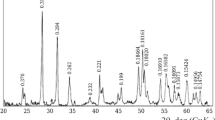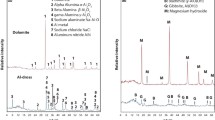Conclusions
Chrysoberyl on an alumina and beryllium oxide basis was synthesized and its main refractory and ceramic properties investigated.
The effects of various mineralizing agents on the degree of crystallization and on the fusion of aluminum and beryllium oxide were also determined. Lithium and calcium oxides were found to be the most active mineralizing agents.
The chrysoberyl reaction occurred within the 1700 to 1800 solidification range reaching the highest intensity upon additions of about 2% Li2O or CaO.
Synthesized chrysoberyl possesses valuable insulating and refractory properties.
The production of chrysoberyl masses does not differ from the regular manufacturing process of goods from highly refractory oxides. The following sequence of operation should be adopted: prefiring of basic oxides at 1600 to 1650 C, milling and thorough mixing of components, addition of the mineralizer, pressing with the addition of an organic plasticizer and firing at 1750 to 1800 C. The toxicity of beryllium oxide requires a strict reinforcement of safety regulations.
The results of the paper may serve as a basis for the further development of a production process for refractory chrysoberyl masses involving the use of alumina and beryllium oxide.
Similar content being viewed by others
Bibliography
D.D. Dehn, et al., The System of Mineralogy, Vol. I, “Oxides and Hydroxides,” translation from English, 1951.
H. Wartenberg, H.I. Reusch. Zeit. anorg. allgem. Chem., 1937, 230, 3, 257.
R.F. Geller, P.I. Javorcky, B.L. Steiermann, A.S. Creamer, J. Research. N.B. St., 1945, No. 34, p. 295.
R.F. Geller, P.I. Javorcky, B.L. Steiermann, A.S. Creamer, J. Research, 1948, No. 36, p. 277.
W.R. Foster, H.F. Royal, Journ. Amer. Cer. Soc., 1949, No. 32, p. 26.
P.P. Budnikov, V.G. Avetikov, Ye.I. Dudavskiy, A.A. Zvyagil'sky, Transactions of the Ac. of Sc., USSR, No. 68, 1949, p. 2.
S.M. Lang, C.D. Fillmore, L.H. Maxweell, J. Research N. B. St., No. 48, 1952, p. 4.
F.Ya. Galakhov, “Investigation of the Alumina Field In Alumumino-Silicate Systems,” Doctor Thesis, 1958.
F.Ya. Galakhov, “An Advanced Scientific Experiment,” Branch of the All-Union Institute of Scientific and Technical Information, subject 34, No. 57-57/12, Moscow, 1957.
Author information
Authors and Affiliations
Rights and permissions
About this article
Cite this article
Fedoseyev, A.D. Synthesis of chrysoberyl and investigation of its suitability as a refractory. Refractories 2, 230–235 (1961). https://doi.org/10.1007/BF01301136
Issue Date:
DOI: https://doi.org/10.1007/BF01301136




